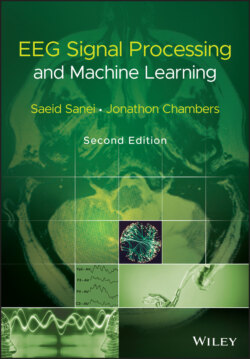Читать книгу EEG Signal Processing and Machine Learning - Saeid Sanei - Страница 49
3.4.2 Nonlinear Modelling
ОглавлениеAn approach similar to AR or MVAR modelling in which the output samples are nonlinearly related to the previous samples, may be followed based on the methods developed for forecasting financial growth in economical studies.
In the generalized autoregressive conditional heteroskedasticity (GARCH) method [36], each sample relates to its previous samples through a nonlinear (or sum of nonlinear) function(s). This model was originally introduced for time‐varying volatility (honoured with the Nobel Prize in Economic sciences in 2003).
Nonlinearities in the time series are declared with the aid of the McLeod and Li [37] and (Brock, Dechert, and Scheinkman) tests [38]. However, both tests lack the ability to reveal the actual kind of nonlinear dependency.
Generally, it is not possible to discern whether the nonlinearity is deterministic or stochastic in nature, nor can we distinguish between multiplicative and additive dependencies. The type of stochastic nonlinearity may be determined based on Hsieh test [39]. The additive and multiplicative dependencies can be discriminated by using this test. However, the test itself is not used to obtain the model parameters.
Considering the input to a nonlinear system to be u(n) and the generated signal as the output of such a system to be x(n), a restricted class of nonlinear models suitable for the analysis of such process is given by:
(3.52)
Multiplicative dependence means nonlinearity in the variance, which requires the function h(.) to be nonlinear; additive dependence, conversely, means nonlinearity in the mean, which holds if the function g(.) is nonlinear. The conditional statistical mean and variance are respectively defined as:
(3.53)
and
(3.54)
where χn‐1 contains all the past information up to time n‐1. The original GARCH(p,q) model, where p and q are the prediction orders, considers a zero mean case, i.e. g(.) = 0. If e(n) represents the residual (error) signal using the above nonlinear prediction system, we have:
(3.55)
where αj and βj are the nonlinear model coefficients. The second term (first sum) in the right side corresponds to a qth order moving average (MA) dynamical noise term and the third term (second sum) corresponds to an AR model of order p. It is seen that the current conditional variance of the residual at time sample n depends on both its previous sample values and previous variances.
Although in many practical applications such as forecasting of stock prices the orders p and q are set to small fixed values such as (p,q) = (1,1); for a more accurate modelling of natural signals such as EEGs the orders have to be determined mathematically. The prediction coefficients for various GARCH models or even the nonlinear functions g and h are estimated iteratively as for the linear ARMA models [36, 37].
Such simple GARCH models are only suitable for multiplicative nonlinear dependence. In addition, additive dependencies can be captured by extending the modelling approach to the class of GARCH‐M models [40].
Another limitation of the above simple GARCH model is failing to accommodate sign asymmetries. This is because the squared residual is used in the update equations. Moreover, the model cannot cope with rapid transitions such as spikes. Considering these shortcomings, numerous extensions to the GARCH model have been proposed. For example, the model has been extended and refined to include the asymmetric effects of positive and negative jumps such as the exponential GARCH model EGARCH [41], the GJR‐GARCH model [42], the threshold GARCH model (TGARCH) [43], the asymmetric power GARCH model APGARCH [44], and quadratic GARCH model QGARCH [45].
In these models different functions for g(.) and h(.) in (3.48) and (3.49) are defined. For example, in the EGARCH model proposed by Glosten et al. [41] h(n) is iteratively computed as:
(3.56)
where b, α 1, α 2, and κ are constants and ηn is an indicator function that is zero when un is negative and one otherwise.
Despite modelling the signals, the GARCH approach has many other applications. In some recent works [46] the concept of GARCH modelling of covariance is combined with Kalman filtering to provide a more flexible model with respect to space and time for solving the inverse problem. There are several alternatives for solution to the inverse problem. Many approaches fall into the category of constrained least‐squares methods employing Tikhonov regularization [47]. Among numerous possible choices for the GARCH dynamics, the EGARCH model [41] has been used to estimate the variance parameter of the Kalman filter iteratively.
Nonlinear models have not been used for EEG processing. To enable use of these models the parameters and even the order should be adapted to the EEG properties. Also, such a model should incorporate the changes in the brain signals due to abnormalities and onset of diseases.
